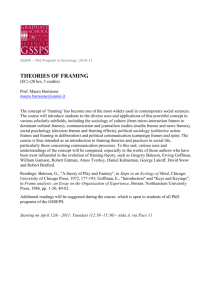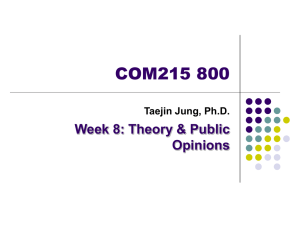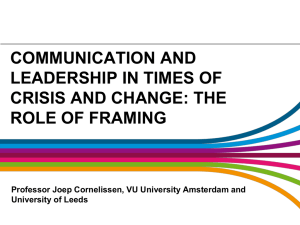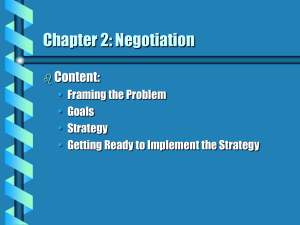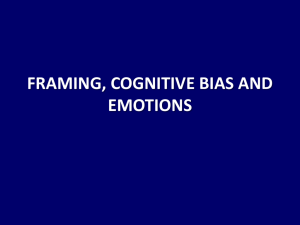Framing 101–Advocate's College III, Session I PowerPoint
advertisement
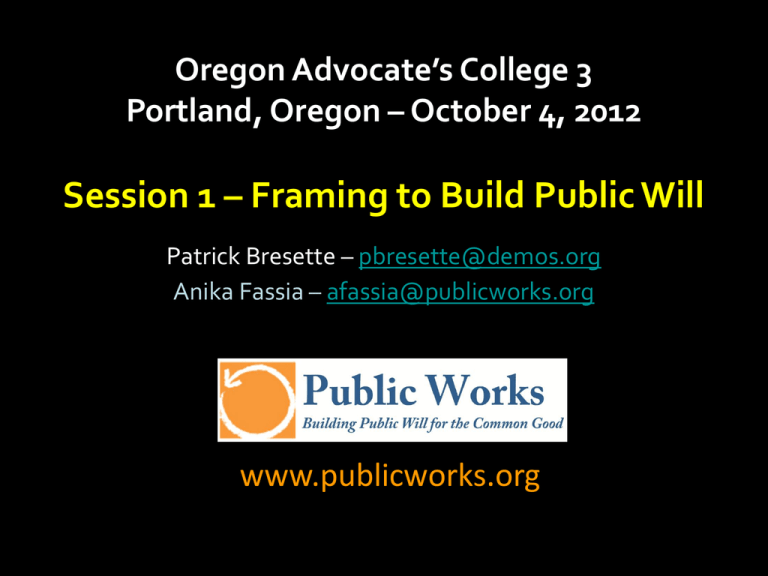
Oregon Advocate’s College 3 Portland, Oregon – October 4, 2012 Session 1 – Framing to Build Public Will Patrick Bresette – pbresette@demos.org Anika Fassia – afassia@publicworks.org www.publicworks.org Building public support for a government dedicated to the common good and empowered to address the challenges and opportunities of the 21st Century. The Work of Public Works Research • Government • The Economy • Budgets & Taxes In the Field • Policy Shops • Advocates • Coalitions • Electeds & Managers • Unions What We are Trying to Understand Polling: Looking for Visible Attitudes Our Research: Looking for Hidden Reasoning America is at a cross-roads: Public Challenges and Public Will We Need to Build Public Will "Public sentiment is everything. With public sentiment, nothing can fail; without it nothing can succeed. Consequently, he who molds public sentiment goes deeper than he who enacts statutes or pronounces decisions. He makes statutes and decisions possible or impossible to be executed.“ - Abraham Lincoln Lessons from Social Movements Framing – as a tool in social movements – refers to “the conscious, strategic efforts by groups of people to fashion shared understandings of the world and of themselves that legitimate and motivate collective action.” - McAdam, McCarthy and Zald 1996 Lessons from the Civil Rights Movements Frames • Christian Values • Democratic Ideals • Charity, redemption & Non-Violence • Compelling Messengers & Diverse supporters • Tactical Innovations • Public (shared) solutions Outcomes • Influenced media coverage • Tapped into bedrock American Values • Raised broad awareness and support • Defused the opposition • Called government to action for the common good Frames and Social Movements “I am about to sign into law the Civil Rights Act of 1964. I want to take this occasion to talk to you about what that law means to every American. Not black people. Not Southerners. Not even our nation. Every American. . . . . . should we defeat every enemy, and should we double our wealth and conquer the stars, and still be unequal to this issue, then we will have failed as a people and as a nation . . . Their cause must be our cause, too. Because it is not just Negroes, but really it’s all of us who must overcome the crippling legacy of bigotry and injustice.” “Party in Search of a Notion,” by Michael Tomasky, American Prospect, May 2006. Our Goals • To learn how to frame and reframe our issues to create better public understanding of - and support for the policy changes we seek. • This is “strategic” communications Today’s Session • What is “framing” • How do dominant stories, frames & perceptions shape understanding • What are the tools of good framing practice • What are framing missteps to avoid What is a “frame”? “…organizing principles that are socially shared and persistent over time, that work symbolically to meaningfully structure the social world…. Frames structure. That is, they impose a pattern on the social world.” - Stephen Reese in Framing Public Life, 2001 Different Goals • Agenda-setting: Influencing which issues people think are important for government to address. • Framing: Influencing how people think about and interpret ideas and issues, particularly how they think about solutions to problems. Framing vs. Spin • Frames are always present • Framing for Understanding vs. Spinning to Deceive • Reveal vs. Obscure • Perspective not Manipulation. Framing Framing research examines how thinking, communication, and culture interact, and understanding those interactions can help advocates determine how to communicate more effectively. - Larry Wallack Communicating to Build Public Will Questions that we need to answer: • What is the problem? • Why does it matter? • Who is responsible? • What should be done? Spanking Makes You Stupid Development, not IQ Early experiences affect the architecture of the maturing brain and establish either a sturdy or a fragile foundation for all of the development and behavior that follows. When a young child experiences excessive stress, chemicals are released in the brain that damage its developing architecture. These stress chemicals make it harder for brain cells to grow and connect to each other. Framing Happens • Frames are used by our brains to make sense of incoming information • It happens fast • Frames fill in the blanks • They direct thinking RQYFPTX patterns of association media cultural models frames knowledge stories experience myths We are not blank slates stereotypes Frames are mental structures that help people understand the world, based on particular cues from outside themselves that activate assumptions and values they hold within themselves. Berkeley Media Studies Group Sam is a Snake • Would lend money to Sam? • Would you let him housesit? • Would you like him to date your friend? • Would you trust him to keep a secret? Framing is Always Happening If we do not pay attention to how we frame our issues people will default to the “pictures in their heads” Essential Steps for the Future of America's Wetlands As citizens committed to maintaining and restoring a diversity and abundance of wetlands for future generations of people and wildlife we urge our elected officials to work [to improve environmental regulations and provide funding for restoration]. Why Wetlands Matter Wetlands benefit us all. Wetlands act as a filter for the waters of our lakes, rivers and streams. Wetlands improve the water we drink, and the air we breathe. Wetlands act like giant sponges. They soak up rain and snowmelt as they occur, serving as temporary storage basins, thus reducing erosion, and limiting the destruction caused by severe floods . . . CITY I confess to a prejudice. I believe that Cities are the most important single unit of human society. They are to human beings what beehives are to bees. Human beings are fundamentally community beings . . . No other level of government has to face so directly the reality of how well we or poorly we work as a human community. We are bound together. The municipal leader knows it, and sees it. Pragmatism, Prophecy, and Prayer -The Rev. B. P. Campbell, Virginia Municipal League, Prayer Breakfast, 24 October 2005 Some beliefs to question The facts will set you free. The data speak for themselves. We need to educate everyone. We just need a catchier message/slogan. I understand it so everyone else should. Those who don’t support us don’t make sense. Facts do not Trump Frames Understanding means finding a story you already know and saying, “Oh yeah, that one.” Even just one piece of affirming information about a stereotype is sufficient to confirm the entire stereotype, whereas presentation of even several disconfirming cues has little effect on disconfirming the stereotype. - (Schank, 1998 & Gurwitz and Dodge, 1977) The Limits of “Facts” Facts do not penetrate the world where our beliefs abide; facts did not give birth to our beliefs, and they do not destroy them. Facts can contradict beliefs constantly without weakening them in the least... - Proust Frames vs. Facts . . . your experiences? Golden Voice: http://www.youtube.com/watch?v=1cl_fMxQCTw&feature=related Frames Influence Decisions “Every frame defines the issue, explains who is responsible, and suggests potential solutions. All of this is conveyed by images, stereotypes, or anecdotes.” - Charlotte Ryan, Prime Time Activism, 1991 Alternative Frames Youth at Home Disobeys Warnings: Knocked out in storm-related accident Girl at Home Injured during Storm: Home had been cited for building code violations Teen hurt in freak storm: “I was terrified.” Dominant Frames • • • • • • • Self-determination/Self discipline Rugged individualism Benefits based solely on effort Limited obligation to collective good Neutrality of major social institutions Voluntary and moral nature of behavior Limited government intervention The Rockridge Institute Social Justice Frames • • • • • • Shared responsibility Strong obligation to collective good Unequal starting positions require remedy Focus on social conditions Basic benefits should be assured Community well-being supersedes individual well-being • Government involvement necessary The Rockridge Institute The Triumphant Individual “Self-Made Man” – Irene Ritter Independence The Benevolent Community Dave Kolpack / AP Interdependence Individual Problem Collective Problem Personal Solutions Structural Solutions Core Beliefs about Poverty • Each individual is responsible for his or her own success or failure; • With hard work comes reward; • The goal is equal opportunity, not equal outcome; and • Anyone can achieve the “American Dream”. Source: Meg Bostrom, For an Economy that Works for All Narratives We’re up Against Poverty is…. • a result of poor choices or bad morals • not as bad as it used to be or as it is elsewhere • a temporary state because of America’s unique economic mobility • not solvable and attempting to solve it will be expensive and will cause dependence Dominant Frames are Constantly Reinforced There comes a time when compassion can cause disaster. If you open your home to scores of homeless folks, you will not have a home for long. There is a capacity problem for every noble intent. America remains the land of opportunity, but you have to work for it. The unemployment rate for college graduates is 5%. For high school drop-outs, it is 16%. Personal responsibility is usually the driving force behind success. But there are millions of Americans who are not responsible, and the cold truth is that the rest of us cannot afford to support them. Every fair-minded person should support government safety nets for people who need assistance through no fault of their own. But guys like McDermott don't make distinctions like that. For them, the baby Jesus wants us to "provide," no matter what the circumstance. But being a Christian, I know that while Jesus promoted charity at the highest level, he was not selfdestructive. The Lord helps those who help themselves. Does he not? - Bill O’Reilly, December 9, 2010 Which story are we reinforcing? Burst for Prosperity seeks to build thriving, resilient communities in Washington State. We believe communities rise and fall as one. When we allow one part of the community to weaken, it weighs us all down. We strive to strengthen and transform communities by putting in place strong public systems (like subsidized child care and job training and education) that help all families attain the stability and security that come with good jobs. Some Public Beliefs work for us . . . • Hard work should be valued and rewarded • Working people are struggling • The country needs to act to impact the economy • People tend to judge the economy based on their perceptions of how they and people like them are doing. • We can all work together to find solutions Community Action changes people’s lives, embodies the spirit of hope, improves communities and makes America a better place to live. We care about the entire community, and we are dedicated to helping people help themselves and each other. The importance of framing “If they can get you asking the wrong questions, they don't have to worry about answers.” - Thomas Pynchon, Gravity’s Rainbow Discussion : How are the issues you work on “framed” in the public mind? Are there unique Oregon “frames” that impact your work? What about “Independence vs. Interdependence” Speaking to Values Directs Thinking Values Matter • We reason first from deeply held values. • Values help answer: “Why does this matter to me/us?” • We need to start with Values, not with the policy and program details Levels of Thinking • Level One – Big ideas: protection, justice, family well-being, equality, opportunity, prosperity • Level Two – Issues: housing, the environment, children’s issues, workforce development • Level Three – Policies: pay equity, bycatch, SCHIP presumptive eligibility, EITC Why does this matter? “Every child should have access to immunizations but too many families in our community are not bringing their children in to our clinics. This is why we are proposing a new agency rule requiring more clinic hours . . .” Speak to Values First “The health of the whole community is protected when we ensure that our children are immunized. One of the ways we do this is through our public health agencies that provide free and low cost immunizations for all children. We need extended clinic hours to keep up with growing demands. ” How do you talk about a $27 billion budget shortfall? How We Approached the Challenge • Working in coalition • Attuned to communications research • Discipline in messaging Our Vision A Story about Texas and what is at stake Values Matter • What are the overarching values that underpin your issue areas? • Can you trace your policy recommendations back to a level one value? George Lakoff: Don’t Think of an Elephant! By raising the precise frames we are intending to counter, even if only to refute them, we are creating hurdles we now must jump over. Moreover, we may be suggesting these arguments to those who had not yet considered them. Reinforcing the Opposing Frame "The governor is not talking about taking away people's French fries. He just wants to offer them the choice of having carrots." Oregon's governor wants healthier state work force, but vendors say don't take the Snickers (The Oregonian, 10/6/10) “Hookah lounges promote a social norm that smoking is cool and safe…” Hookah smokers say doctors are too huffy (The Hillsboro Argus, 11/16/10) Reinforcing a Counter Frame "It seems like a naïve goal. Poverty has been around forever, and the homeless, no matter how prosperous a nation or a county might be, seem to be omnipresent. But in 2008, Fairfax County… committed itself to preventing and ending homelessness in 10 years.“ Dedicated to ending homelessness by 2018 The Washington Post, 8/18/11 “The stereotype of homeless people as single, middle-aged adults doesn’t really apply in Washington County.” Helping Homeless Families in Washington County OPB Radio, 5/22/08 Potential Elephant Indicators • Not “This is not about….” “We are not…” • Don’t / Won’t “We don’t intend to ____, rather…..” • But “This can be an issue of ____, but….” “It is expensive, but…” • Nevertheless, etc. Before & After from AFSCME Council 8 About us About the union About the service The “But” rule BEFORE AFTER Shared value Discussion • How does the “elephant” problem show up in your efforts • The challenge of “myth/fact” efforts tone matters Tone is a Frame Signal • Highly rhetorical and angry tone can unnecessarily polarize and partisan-ize • Tends to set up a defensive or “fight back” response • Raises suspicion of motivation • Using pragmatic and reasonable tone can keep “listening and learning” open “Greedy developers have their sights set on a 50 acre parcel of land in the middle of Westwood. Unless government steps in, all we’ll get there is more expensive housing and big box stores that exclude the poor and powerless in our community.” “Our communities are strongest when economic development works for everyone. We need to use our public systems and structures to ensure that new development in Westwood benefits the entire community. It is time for an inclusive planning process to . . .” telling stories with numbers Numbers don’t tell stories by themselves “Social Math” can make numbers more vivid and understandable The Numbing Use of Numbers According to the [TPEP] fact sheet, 5,246 adults in Crook County regularly smoke cigarettes in one year. Regarding serious illness caused by tobacco use, 1,270 people suffer in the county per year. An average of 65 people dies from tobacco-use each year, and $10 million is spent on medical care for tobacco-related deaths. In 2009, 27 percent of adults were smokers, compared to 19 percent statewide and 15 percent of males used smokeless tobacco, compared to 6 percent statewide. There were 13 percent of eighth graders that used cigarettes in Crook County, compared to nine percent statewide, and 22 percent of 11th graders, compared to 17 percent statewide. 12 percent of 8th grade males used smokeless tobacco in Crook County, and 19 percent of 11th grade males. Local cigarette use exceeding state average , Central Oregonian, 8/26/10 Social Math Making large numbers comprehensible and compelling by placing them in a social context that provides meaning. - Pioneered by the Advocacy Institute and Berkeley Media Studies Group Constructing Social Math Convert large numbers into images to which people can relate. • • • • • Break down numbers by time Break down numbers by place Provide comparisons with familiar things Provide ironic comparisons Personalize numbers News For Change, 199 “Framing with Numbers” Social math can help set a new frame by : (1) connecting two or more things together; (2) comparing the size of things; or (3) functioning as a metaphor. - The FrameWorks Institute Connect to the Familiar One less coal plant is like cutting 40 percent of Washington's vehicle emissions. That amounts to all the cars and trucks in Seattle, Tacoma, and Spokane plus the 25 next largest cities in the state, combined. 37g of Fat + = + Social Math Results The story was an immediate sensation, featured on CBS, NBC, ABC, CNN , the front pages of USA Today, the Los Angeles Times, and The Washington Post's Style section. Headlines: "Popcorn Gets an 'R' Rating," "Lights, Action, Cholesterol!" "Theater Popcorn is Double Feature of Fat." Moviegoers were repulsed. Sales plunged. Soon after, most of the nation's biggest theater chains — including United Artists, AMC, and Loews-announced that they would stop using coconut oil - From “Made to Stick” Connect “this to that” for Context In San Francisco, there is one police officer for every 18 young people and only one school counselor for every 500 kids. For the cost of incarcerating one prisoner for one year, California could send two students to the University of California, three students to a California state university or seven students to a community college. Connect to the Familiar Community residents near a gasoline refinery noted that the plant emits 6 tons of pollutants per day – that’s 25 balloons full of toxic pollution for each school child in the town. Scale and Size “If the fishing industry were a country, it would rank with the Netherlands as the world’s 18th-largest oil consumer, a team of fisheries scientists is reporting. Boats often carry so much fuel ‘they leave the dock lower in the water than when they return with a hold full of fish,’ Dr. Tyedmers said. “Fishing Industry’s Fuel Efficiency Gets Worse as Ocean Stocks Get Thinner,” Cornelia Dean, The New York Times, December 20, 2005 Social Math Examples • College students drink enough alcohol to fill 3500 Olympic-sized swimming pools per year. • As many students will eventually die of alcohol-related causes as will get their masters and doctoral degrees. News For Change, Harper’s Index Font of Social Math Number of candy-bar wrappers needed to win a basketball as part of Cadbury’s new anti-obesity campaign: 90 Number of hours an 85-pound child would need to play basketball in order to burn off the calories in that many candy bars: 100 - Harper’s Index, August 2003 Some Hints • Avoid additional “nifty” statistics; be sure to convert existing data into readily identifiable, easily intelligible equivalents. • Equivalents should be intuitive and readily digestible; avoid complexity. • Watch for logical “gaps” in the associations you make. Be sure to close each or your audience will fall in! • Change to commonly-experienced “units” rather than comparing with less widely-familiar things . • Thinking both “visual” and “visceral” can be helpful. Bad Food? Tax It, and Subsidize Vegetables ~ M. Bittman July 23, 2011 New York Times Frame Deconstruction Exercise “. . . A talent for speaking differently, rather than for arguing well, is the chief instrument of cultural change . . .” - Richard Rorty

